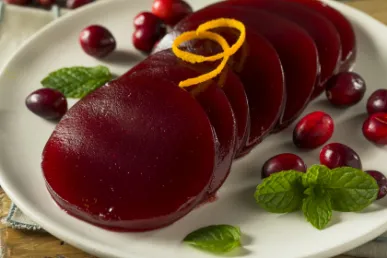Cranberries: The Thanksgiving side you might want to eat year-round
Had we known all these years how good cranberries are for us, our Thanksgiving plates might have looked different.
Cranberries are jam-packed with nutrients. A powerhouse of antioxidants, they contain vitamins and minerals like vitamins C, E and K. They’re also made up of healthy fiber, carbs, and about 90% water.
Raw, fresh cranberries are the most nutritious. But because they taste sour, they’re not as popular as dried cranberries, cranberry juice, and the other ways we enjoy cranberries: with sugar.
But forget about the added sugar for a minute. Check out these health benefits of cranberries. You might decide to add raw cranberries to your diet while being more aware of the sugar content in the more palatable varieties.
That’s because cranberries can help:
-
Fight cavities
Cranberries have large amounts of “polyphenols” and “A-type proanthocyanidins” that prevent bacteria from growing. After you’ve eaten cranberries, these plant micronutrients stay in your saliva and help prevent tooth decay, gum disease and oral cancer.
-
Protect your gut
Speaking of “A-type proanthocyanidins,” they’re found only in cranberries. They add good bacteria to your digestive system and can help stop infections before they start. They also give cranberries their bright red color.
-
Reduce inflammation
Cranberries are high in antioxidants, which can help lower inflammation in our bodies. That can help reduce the risk of some chronic illnesses such as type 2 diabetes and heart disease.
-
Improve heart health
Studies show some evidence that cranberries can potentially help raise HDL (good) cholesterol and lower LDL (bad) cholesterol.
Can cranberries treat UTIs?
No. Cranberries can’t cure a urinary tract infection (UTI).
So why are cranberries thought of as a way to prevent and treat UTIs?
It’s the “A-type proanthocyanidins” again. The same compounds that promote a healthy digestive system and fight cavities also help stop bacteria from sticking to bladder cells in laboratory settings. More studies are needed to see if the same is true in humans.
In the meantime, eating cranberries or drinking cranberry juice won’t hurt you and might end up lowering your risk of getting a UTI.
Cranberry side effects
Most people can eat cranberries or drink cranberry juice with no problems. But if you’re on blood thinners or have a history of kidney stones, check with your doctor to see if cranberries are safe for you.
Cranberries have vitamin K, which can interfere with blood thinner medication. And kidney stones are commonly made up of calcium oxalate. Cranberries contain high levels of oxalate.
So, as you gather with family and friends over the holidays, you might give this year’s rendition of the cranberry side dish some love.
How to select, store and eat cranberries
Fresh cranberries …
- Make their appearance in stores from October to December.
- Are firm and plump — they’ll bounce if you drop them.
- Should be kept in the fridge in a tightly sealed plastic bag. They’ll last for a few weeks.
- Shouldn’t be washed until you’re ready to eat them.
- Can be frozen for later use in smoothies, sauces, relishes, fruit salsas, and with apples in pies.
Prefer dried cranberries?
- Toss them in plain yogurt, oatmeal, salads and cookies.
- Add them to homemade trail mix instead of candy pieces.
- Look for unsweetened dried cranberries in health food stores or online.
Fun facts: jellied cranberry sauce
- Americans consume over 5 million gallons of jellied cranberry sauce every holiday season.
- Ocean Spray®, the largest producer of cranberry products in the United States, produces about 79 million cans of jellied cranberry sauce each year — the majority sold during the Thanksgiving and Christmas holidays.
- It takes about 200 cranberries to make one can of cranberry sauce.













